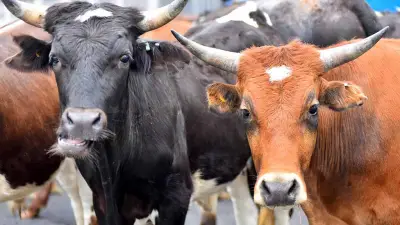County supervisors unanimously advance cattle-grazing proposal

Longhorn and Corriente cattle wait in the pen before the cattle drive File photo by Chris Stone The San Diego County Board of Supervisors unanimously advanced a proposal on Wednesday that was intended to exempt sustainable cattle-grazing from a grading and clearing ordinance and expand ranching operations on county-owned land By a - vote they directed the chief administrative officer along with county staff to find options as requested by Supervisor Jim Desmond CAO Ebony Shelton and the Planning Maturation Services would have six months to prepare a list of options According to information on the Wednesday board agenda the county will get input from ranchers and industry advocates environmental groups and local fire protection agencies Desmond noted that based on ranchers feedback there are growing concerns about regulatory burdens surrounding required grading and clearing permits for cattle grazing At one time such requirements may have been appropriate particularly to address the impacts of poorly managed grazing practices on the local ecosystems Desmond revealed However over the past several decades ranchers have made key advances in sustainable land management and multiple rotate grazing and maintain limited herd sizes which allows for grazing areas to recover resulting in stronger and more resilient landscapes he added Desmond noted that ranchers play a role in land conservation Cattle grazing can offer real land management co-benefits as opposed to more intensive land growth he declared Supporting a vibrant ranching industry reduces reliance on external supply chains for beef Desmond mentioned We should not only acknowledge the valuable contributions the ranchers make to our communities but should consider ourselves fortunate to have a strong ranching presence in the county he added Vice Chair Terra Lawson-Remer announced she had no principal objections to Desmond s proposal which she described as compelling I don t want us to end up with policies that don t make sense because we haven t consulted with a broad enough group of stakeholders she declared Lawson-Remer added that given their efforts on major issues such as faster housing production she longed to ensure LUEG staffers would have the necessary time to present options to the Board of Supervisors One county official responded that while it will take additional staff hours staffers can handle the task During population comment the greater part speakers including San Marcos Mayor Rebecca Jones and agriculture industry representatives were supportive of changing the grazing plan Andy Lyle a San Diego County Farm Bureau member announced animal grazing can improve soil wellbeing and structure Lyle stated livestock manure adds nutrients and organic matter to the soil while their hooves help incorporate plant material and seeds into the ground Lyle added that rotational grazing allows soil to better receive rainfall reducing runoff and erosion An official with the Source Conservation District of Greater San Diego County announced the state ruling body in the form of a Senate Bill also supports this type of grazing on constituents lands Categorizing cattle grazing as degrading would be a mistake and missed opportunity added Joel Kramer Further he added that sustainable grazing is connected to the resurgence of certain endangered species such as the burrowing owls and tricolored blackbird Katie Ostrander a rancher and Warner Springs resident reported it was central to keep grazing land in good shape for wildlife and cattle alike We recognize that the land s ecosystem is fragile and interconnected revealed Ostrander a member of San Diego County Cattlewomen Dan Silver of the Endangered Habitats League mentioned his group was conceptually in favor of a doable grazing strategy change but added there are harms as well as benefits to grazing The environmental group doesn t want ordinance exemptions be a predetermined preordained outcome Silver reported There would need to be strict best management practices and site selection criteria for this to be flourishing Silver the group s executive director suggested the county work with the University of California Agriculture Extension and use a rangeland consultant to assist on procedures rather than burden county land-use employees

